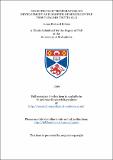Files in this item
The effects of temperature on development and growth of muscle in the trout (Salmo trutta (L.))
Item metadata
| dc.contributor.advisor | Johnston, Ian A. | |
| dc.contributor.advisor | McLay, Anne | |
| dc.contributor.author | Killeen, James Richard | |
| dc.coverage.spatial | 252 p. | en_US |
| dc.date.accessioned | 2018-07-05T13:52:03Z | |
| dc.date.available | 2018-07-05T13:52:03Z | |
| dc.date.issued | 1999 | |
| dc.identifier.uri | https://hdl.handle.net/10023/15000 | |
| dc.description.abstract | Trout (Salmo trutta L.) were reared in a hatchery environment under a variety of temperature regimes, and patterns of early development and growth were studied. The period from fertilisation to 'first feeding' (i.e. when the yolk supply was almost exhausted) was described as a series of forty successive developmental 'steps'. A quantitative scoring system, whereby individual embryos were assigned points ranging from 1 to 1000 on the basis of assessment of numerous developmental features, was also developed. Trout reared at 10° achieved greater values of developmental score and standard length, but lower values of body mass, from a given quantity of yolk compared to trout reared at 2°. Yolk was used less efficiently for differentiation but more efficiently for growth in larger eggs. Although certain events, such as hatching, occurred relatively earlier at higher temperatures, the relative timings of most individual developmental changes, including myotube and muscle fibre formation and many aspects of neural development, did not vary with temperature. Muscle growth, particularly recruitment of new muscle fibres, was lower relative to developmental score and to length at 10° than at 2°. However, trout at first feeding of comparable total muscle area had significantly greater numbers of post-embryonic fibres when reared at the higher temperature, indicating the onset of a compensatory 'catch-up' in fibre recruitment. The effects of the migratory type of the female parent on development and growth of embryos and alevins were also investigated, but were found to be minimal. During a study examining the effects of forced exercise on growth, juvenile trout reared at 10° as embryos exhibited a greater potential for somatic growth and recruitment of new muscle fibres than those reared at 2°. It is postulated that this difference in growth potential is related to the higher numbers of myonuclei present in the 10°-reared fish. | en_US |
| dc.language.iso | en | en_US |
| dc.publisher | University of St Andrews | |
| dc.subject.lcc | QL638.S2K5 | en |
| dc.subject.lcsh | Trout | en |
| dc.title | The effects of temperature on development and growth of muscle in the trout (Salmo trutta (L.)) | en_US |
| dc.type | Thesis | en_US |
| dc.contributor.sponsor | Fisheries Research Services Fund | en_US |
| dc.type.qualificationlevel | Doctoral | en_US |
| dc.type.qualificationname | PhD Doctor of Philosophy | en_US |
| dc.publisher.institution | The University of St Andrews | en_US |
This item appears in the following Collection(s)
Items in the St Andrews Research Repository are protected by copyright, with all rights reserved, unless otherwise indicated.

